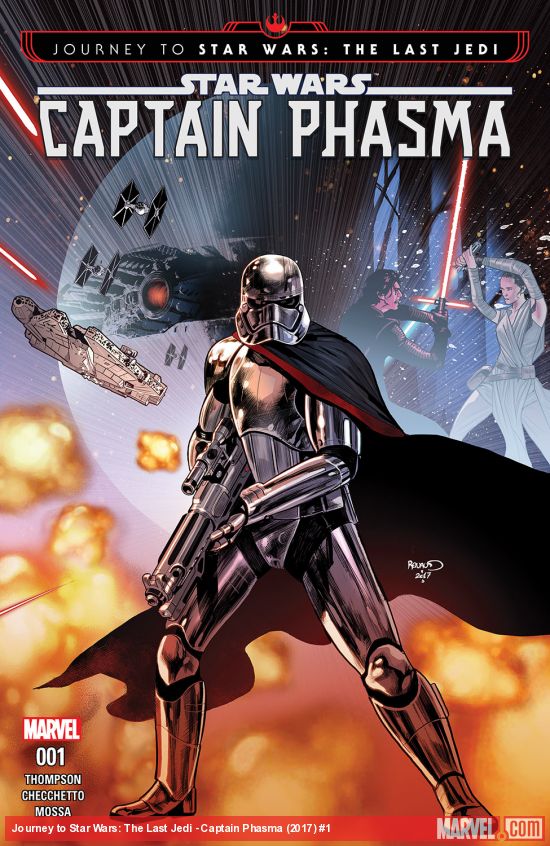Comic Review: “Captain Phasma #1”
Star Wars has some really good bad guys. Jabba the Hutt, Darth Maul, and of course, Boba Fett. Fans lock onto them right away and are fascinated by their mystique and threat. Boba had a mechanized voice and a brooding presence. Maul looked like a nightmare, especially with his unbrushed teeth and pointy scalp. Jabba was mentioned for three movies before finally being introduced in Episode VI as a huge, lazy, lusty slug (we are just going to ignore his appearance in the Episode IV Special Edition. That never happened.) And in every instance, these awesome baddies were killed off right away.
In The Force Awakens, J.J. Abrams followed suit with a mysterious threat, the shiny Captain Phasma. Phasma's first appearance in an Episode VII preview generated as much buzz as did the tattooed Maul with his double bladed saber. But...Abrams seemed determined to break the disappointing mold. First, he cast the part to a woman, the beautiful, tall and talented Gwendoline Christie. And second, he allowed her to live past what many assumed was her undignified demise at the end of Episode VII (even though we all know that you can't die from being put in a trash compactor).
Boba and Maul have also survived their film-deaths, thanks to the miracle of comics, and in a like manner we find ourselves learning more about the post film fate of Phasma in Marvel's new four-issue miniseries, Captain Phasma #1, released on September 6th, 2017 as part of the build up to the release of The Last Jedi.
The very first thing that captured my joy when reading this title was Marco Checchetto's gorgeously drawn panels. They are so rich and deep and action-packed, they almost seem like they are stills from a film. Colorist Andres Mossa has taken on the daunting task of giving life to Checchetto's panels — no easy task since Phasma's chrome armor appears on almost every page. Can you imagine how challenging it would be to render chrome as an artist?
For those that may have forgotten, after having been forced (by threat of Wookiee) to turn off the Starkiller Base's defensive shields and allowing the Resistance fighters to begin attacking the First Order, Phasma is mercifully thrown into the base's trash compactor. (A young Han would have shot her without hesitation, but the old Han has obviously evolved into a kinder, gentler sort of rebel. Not that he wasn't already planning on killing the entire population of a third death laser outpost. But allowing Phasma to live must have made him just a bit more sympathetic to the audience, especially since he would soon be the victim of heartless patricide).
The comic picks up as Phasma is only briefly inconvenienced by her smelly containment. Knowing she's in deep Bantha-poodoo if she is discovered to be the reason for the Base's shield being turned off, she sets out to clear her name.
The genius of this issue comes from writer Kelly Thompson's story device as the issue's events unfold. Often in novels, we trust the narrator and their account of the plot simply because we have no other choice. They tell us what happens or happened, and we go along with it. Sometimes they are honest, but often their version of the story is bent towards their own benefit or perspective. In this issue, Thompson plays with the contrast between what Phasma is reporting to her superiors and the visual, nonbiased account that we are seeing unfold in the illustrations.
As such, I spent much more time with this issue than I usually do reading a comic. I was going back and re-examining the panels to try to suss out Phasma's true intentions and to accurately interpret her motives. Very clever, and a perfect melding of the use of the comic medium to tell an engaging tale.
Ultimately, the title will allow comic readers access to esoteric back story details about The Last Jedi that non-comic audiences will miss, that secret knowledge being an answer to the question of, "Wait! Didn't Phasma die in Force Awakens when Starkiller Base was blown up?"
Because Phasma is back, baby! No ignominious death by Sarlacc or bisection here!


